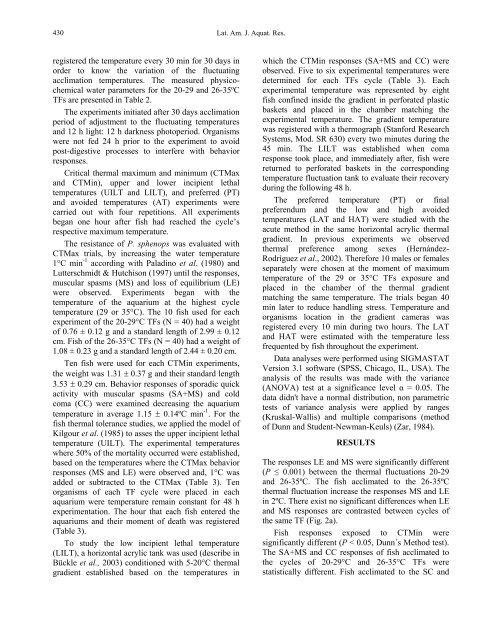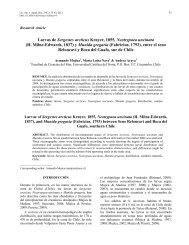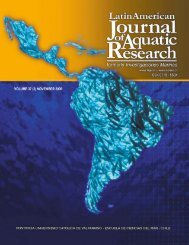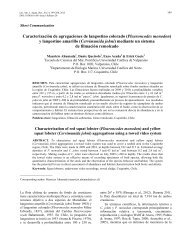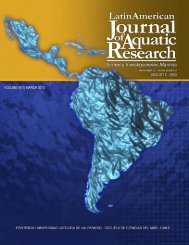Portada LAJAR.psd - Latin American Journal of Aquatic Research
Portada LAJAR.psd - Latin American Journal of Aquatic Research
Portada LAJAR.psd - Latin American Journal of Aquatic Research
Create successful ePaper yourself
Turn your PDF publications into a flip-book with our unique Google optimized e-Paper software.
430<br />
registered the temperature every 30 min for 30 days in<br />
order to know the variation <strong>of</strong> the fluctuating<br />
acclimation temperatures. The measured physicochemical<br />
water parameters for the 20-29 and 26-35ºC<br />
TFs are presented in Table 2.<br />
The experiments initiated after 30 days acclimation<br />
period <strong>of</strong> adjustment to the fluctuating temperatures<br />
and 12 h light: 12 h darkness photoperiod. Organisms<br />
were not fed 24 h prior to the experiment to avoid<br />
post-digestive processes to interfere with behavior<br />
responses.<br />
Critical thermal maximum and minimum (CTMax<br />
and CTMin), upper and lower incipient lethal<br />
temperatures (UILT and LILT), and preferred (PT)<br />
and avoided temperatures (AT) experiments were<br />
carried out with four repetitions. All experiments<br />
began one hour after fish had reached the cycle’s<br />
respective maximum temperature.<br />
The resistance <strong>of</strong> P. sphenops was evaluated with<br />
CTMax trials, by increasing the water temperature<br />
1°C min -1 according with Paladino et al. (1980) and<br />
Lutterschmidt & Hutchison (1997) until the responses,<br />
muscular spasms (MS) and loss <strong>of</strong> equilibrium (LE)<br />
were observed. Experiments began with the<br />
temperature <strong>of</strong> the aquarium at the highest cycle<br />
temperature (29 or 35°C). The 10 fish used for each<br />
experiment <strong>of</strong> the 20-29°C TFs (N = 40) had a weight<br />
<strong>of</strong> 0.76 ± 0.12 g and a standard length <strong>of</strong> 2.99 ± 0.12<br />
cm. Fish <strong>of</strong> the 26-35°C TFs (N = 40) had a weight <strong>of</strong><br />
1.08 ± 0.23 g and a standard length <strong>of</strong> 2.44 ± 0.20 cm.<br />
Ten fish were used for each CTMin experiments,<br />
the weight was 1.31 ± 0.37 g and their standard length<br />
3.53 ± 0.29 cm. Behavior responses <strong>of</strong> sporadic quick<br />
activity with muscular spasms (SA+MS) and cold<br />
coma (CC) were examined decreasing the aquarium<br />
temperature in average 1.15 ± 0.14ºC min -1 . For the<br />
fish thermal tolerance studies, we applied the model <strong>of</strong><br />
Kilgour et al. (1985) to asses the upper incipient lethal<br />
temperature (UILT). The experimental temperatures<br />
where 50% <strong>of</strong> the mortality occurred were established,<br />
based on the temperatures where the CTMax behavior<br />
responses (MS and LE) were observed and, 1°C was<br />
added or subtracted to the CTMax (Table 3). Ten<br />
organisms <strong>of</strong> each TF cycle were placed in each<br />
aquarium were temperature remain constant for 48 h<br />
experimentation. The hour that each fish entered the<br />
aquariums and their moment <strong>of</strong> death was registered<br />
(Table 3).<br />
To study the low incipient lethal temperature<br />
(LILT), a horizontal acrylic tank was used (describe in<br />
Bückle et al., 2003) conditioned with 5-20°C thermal<br />
gradient established based on the temperatures in<br />
Lat. Am. J. Aquat. Res.<br />
which the CTMin responses (SA+MS and CC) were<br />
observed. Five to six experimental temperatures were<br />
determined for each TFs cycle (Table 3). Each<br />
experimental temperature was represented by eight<br />
fish confined inside the gradient in perforated plastic<br />
baskets and placed in the chamber matching the<br />
experimental temperature. The gradient temperature<br />
was registered with a thermograph (Stanford <strong>Research</strong><br />
Systems, Mod. SR 630) every two minutes during the<br />
45 min. The LILT was established when coma<br />
response took place, and immediately after, fish were<br />
returned to perforated baskets in the corresponding<br />
temperature fluctuation tank to evaluate their recovery<br />
during the following 48 h.<br />
The preferred temperature (PT) or final<br />
preferendum and the low and high avoided<br />
temperatures (LAT and HAT) were studied with the<br />
acute method in the same horizontal acrylic thermal<br />
gradient. In previous experiments we observed<br />
thermal preference among sexes (Hernández-<br />
Rodríguez et al., 2002). Therefore 10 males or females<br />
separately were chosen at the moment <strong>of</strong> maximum<br />
temperature <strong>of</strong> the 29 or 35°C TFs exposure and<br />
placed in the chamber <strong>of</strong> the thermal gradient<br />
matching the same temperature. The trials began 40<br />
min later to reduce handling stress. Temperature and<br />
organisms location in the gradient cameras was<br />
registered every 10 min during two hours. The LAT<br />
and HAT were estimated with the temperature less<br />
frequented by fish throughout the experiment.<br />
Data analyses were performed using SIGMASTAT<br />
Version 3.1 s<strong>of</strong>tware (SPSS, Chicago, IL, USA). The<br />
analysis <strong>of</strong> the results was made with the variance<br />
(ANOVA) test at a significance level α = 0.05. The<br />
data didn't have a normal distribution, non parametric<br />
tests <strong>of</strong> variance analysis were applied by ranges<br />
(Kruskal-Wallis) and multiple comparisons (method<br />
<strong>of</strong> Dunn and Student-Newman-Keuls) (Zar, 1984).<br />
RESULTS<br />
The responses LE and MS were significantly different<br />
(P ≤ 0.001) between the thermal fluctuations 20-29<br />
and 26-35ºC. The fish acclimated to the 26-35ºC<br />
thermal fluctuation increase the responses MS and LE<br />
in 2ºC. There exist no significant differences when LE<br />
and MS responses are contrasted between cycles <strong>of</strong><br />
the same TF (Fig. 2a).<br />
Fish responses exposed to CTMin were<br />
significantly different (P < 0.05, Dunn´s Method test).<br />
The SA+MS and CC responses <strong>of</strong> fish acclimated to<br />
the cycles <strong>of</strong> 20-29°C and 26-35°C TFs were<br />
statistically different. Fish acclimated to the SC and


